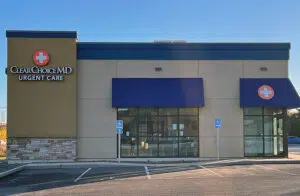Urgent Care Sprains and Inflammation Treatment
Sprains frequently lead to inflammation. A sprain occurs due to a stretched or torn ligament.
The body's response to a sprain triggers an inflammatory response, resulting in various symptoms that can sometimes be uncomfortable and limit mobility. These symptoms include discoloration, swelling, discomfort, and stiffness.
Addressing sprains quickly is essential for facilitating fast and efficient healing. Prompt medical attention can help to prevent further injury, assess the severity of the sprain, and assure appropriate treatment.
ClearChoiceMD Urgent Care services offers effective medical care for minor injuries like sprains and inflammation. Walk-ins welcome – no appointment necessary.
Our team of board-certified medical professionals will assess and treat sprains promptly, minimizing potential complications and providing the necessary guidance and support for a speedy recovery.
What are the Symptoms of Sprains?
The extent of a sprain can run from minor to severe, depending on the damage to the ligaments. Identifying the signs of a sprain is essential for effective treatment, as early intervention can help prevent further damage and promote faster healing.
Symptoms of a sprain involve the following:
- Mild to severe pain that might be localized to the injured region or radiate to other body parts.
- Swelling of the affected area, with severe sprains resulting in more significant swelling.
- Bruising that might occur immediately or become apparent over a few days.
- Limited range of motion that might be temporary or prolonged.
- Tenderness in the injured area, particularly during movement or when the affected area is touched.
- Instability of the injured joint when weight is placed on it, resulting in limping.
It is important to note that these signs are not exclusive to sprains and may also indicate other injuries. If you suspect that you have experienced a sprain, it is recommended that you pursue medical attention for an accurate diagnosis and appropriate treatment.
What's the Difference Between a Sprain and a Fracture?
Sprains and fractures are two common injuries that can occur in various activities and sports.
While both involve damage to the bone or surrounding tissues, they have distinct characteristics and require different treatment approaches.
A sprain is a ligament injury. A ligament is the connective tissue between bones at a joint.
Sprains occur when excessive force or an awkward movement stretches or tears a ligament. They can occur in multiple parts of the body, including ankles, wrists, fingers, and thumbs.
A fracture is a break or a crack in a bone. It can occur due to direct impact, fall, or trauma. Fractures are classified into different types: stable fractures, which involve minimal displacement, and unstable fractures, which require immediate attention.
How are Sprains and Inflammation Treated?
Treatment for minor sprains involves rest, ice, compression, and elevation, commonly known as RICE.
Resting the affected joint is the first and most important step in treating a sprain. Resting means avoiding any actions that strain the joint and provide time for the body to heal.
Applying ice to the sprained joint can help reduce swelling and pain, though it is important to avoid extended contact between ice and skin, as the skin tissues could be damaged as a result.
Compression can be applied by wrapping an elastic bandage around the sprained joint to provide support and stability, which limits swelling.
Elevating the sprained joint can help to reduce swelling and pain by using gravity to drain fluid away from the injured area and promote healing.
Over-the-counter anti-inflammatory pain medications can help reduce discomfort. In some cases, physical therapy can help increase mobility and accelerate healing.
Treating a Sprained Wrist
If you think you have sprained your wrist, it is important to get medical attention. Your doctor will examine your wrist and order imaging tests to confirm the diagnosis and exclude other possible injuries.
A minor wrist sprain can be managed using the RICE method accompanied by non-prescription pain relievers and fever reducers if needed to manage discomfort.
Once the inflammation and pain have subsided, the doctor might recommend physical therapy to strengthen the muscles around the wrist and improve the range of motion. The techniques may include exercises, stretches, and manual therapy techniques.
Recovery time for a sprained wrist can differ based on the seriousness of the injury. Minor sprains might require a week or two to heal, while more serious sprains may require more time.
How a Sprained Knee is Treated at an Urgent Care Center
A sprained knee is a common injury that can occur during various sports, exercise, or even daily activities.
When you visit an urgent care center with a sprained knee, the first crucial step is a thorough evaluation.
The healthcare provider will manually examine your knee and ask about your medical history, including any previous injuries or conditions that may impact the treatment plan. They may also inquire about the events that led to the injury, such as how you landed after jumping, falling, or twisting your knee.
In some instances, your doctor might require imaging tests, such as X-rays, to establish the severity of the sprain and identify any underlying issues.
How a Sprained Ankle is Treated at an Urgent Care Center
Sprained ankles are injuries that occur when a person twists or awkwardly turns their ankle. While they can be painful and limit mobility, ClearChoiceMD Urgent Care offers treatment that minimizes recovery time and promotes healing.
Upon arriving at ClearChoiceMD, you'll be greeted by healthcare professionals who will assess your sprained ankle. They will inquire about your symptoms, such as when the injury occurred, how it happened, and if you have any other medical conditions that could affect your treatment.
The healthcare professional will then examine your sprained ankle. They will check for tenderness, swelling, bruising, and instability in the ankle joint. They may also assess the range of motion and strength of your ankle.
In some cases, an X-ray or MRI is needed to determine the severity of the sprain. These imaging tests can help identify broken bones, torn ligaments, or other injuries requiring further medical attention.
Your healthcare professional will recommend appropriate treatment for your sprained ankle based on your symptoms and examination results. Supplementary treatments may involve the RICE method.
Before leaving the urgent care center, the healthcare professional will provide you with instructions on caring for your sprained ankle at home. They will also let you know when you should follow up with a doctor or return to urgent care for further evaluation.
ClearChoiceMD Urgent Care: Fast Treatment for Sprains and Inflammation
If you experience a sprain or inflammation, it is important to seek medical attention as soon as possible. ClearChoiceMD Urgent Care provides convenient and accessible treatment for minor injuries, including sprains, inflammation, and minor breaks.
Our compassionate staff will work diligently to alleviate your pain, reduce inflammation, and promote healing.
Whether you want to visit immediately or schedule an appointment for your convenience, ClearChoiceMD centers are open seven days a week for your convenience.
Don't let sprains hold you back. Visit one of our 21 urgent care locations today, and let us help you get on the road to recovery.


















